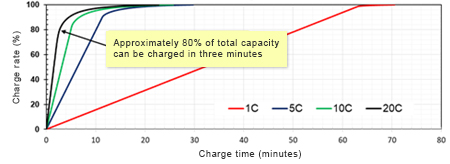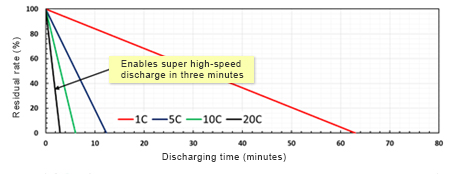Development and Characteristics of Small Lithium-Ion Secondary Batteries
Author: Nichicon
8/23/2018
In recent years, the provision of new products and services utilizing IoT, artificial intelligence and cloud platforms has been on the rise amid the expansion of environmental power generation (energy harvesting) systems that convert light, heat, vibration and radio waves into electricity. Furthermore, the advance of autonomous vehicles that run without drivers Advanced Driver Assistance Systems (ADAS) and other car electronics are creating greater demand for storage batteries.
There is a demand for products that have the ability to charge/discharge with large currents over longer periods of time. Electric double layer capacitors have high power density but low energy density while typical lithium-ion secondary batteries have high energy density but low power density. The Toshiba Infrastructure Systems & Solutions Corporation (hereinafter, “Toshiba”) SCiBTM secondary batteries meet these demands with a technology that addresses the weaknesses of lithium-ion batteries, which include safety, cycle durability, low-temperature usage and high-speed charge-discharge performance. NICHICON licensed this technology from Toshiba and developed small lithium-ion secondary batteries that are especially small in size, enable repeated charge/discharge performance and offer both power and energy density.

Diagram 1: plot for storage batteries
This product utilizes lithium titanate (LTO) for the negative electrodes, possessing high-rate* (20 C maximum) rapid charge/discharge performance similar to electric double layer capacitors. It is also durable, capable of over 18,000 charges/discharges at a rate of 10 C and low temperature characteristics enabling operation at temperatures reaching -30 °C. Furthermore, it is a safe small lithium ion secondary battery with extremely low risk of ignition or smoking due to less lithium metal deposition, which causes deterioration and short circuits.
Structure and Characteristics
In general, the structure of lithium ion secondary batteries is roughly divided into cylindrical, square and button shapes. The small lithium-ion secondary batteries developed by NICHICON are cylindrical, based on the same general structure as our basic electric double layer capacitor and consist of positive and negative electrodes, a separator, electrolytic solution and exterior housing materials.
The positive and negative electrodes are each coated with a thin metal foil layer. LTO, the main material used for the negative electrode, is non-combustible and more thermally stable than carbon-based materials used in many lithium-ion secondary batteries. With the LTO negative electrode specification, there is no reaction with electrolytic solution even at higher temperatures. This reduces the possibility of a reaction between the negative electrode material and the electrolytic solution from triggering thermal runaway. When releasing lithium ions, LTO has the property of changing into a state near that of insulation, and even if a partial short circuit occurs, it does not spread to the entire battery. The LTO surface where the short circuit occurs is insulated, suppressing the advance of the discharge reaction. For this reason, even if an internal short circuit does occur, the battery’s exothermic reaction is dramatically reduced.
Cycle Characteristics
The current rate of charging/discharging a batteries capacity in one hour is defined as 1 C. The retention rate of lithium-ion secondary batteries is about 80% at a 1 C rate. The small lithium-ion secondary batteries developed by NICHICON maintained a capacity of 85% during 18,000 charge/discharge cycle tests conducted at 10 C (charge/discharge in 1/10 of an hour), ten times the rate of typical lithium-ion secondary batteries, making this a device offering excellent cycle life at a high rate (18,000 cycles are equivalent to charging the battery five times a day for about 10 years).

Diagram 2: Charge/discharge cycle characteristics
Rate Characteristics
This product can support high-speed charge/discharge of up to 20 C. When charging at 20 C, an approximately 80% high-speed charge is possible in three minutes, which is optimal for short-time charging applications. In addition, when discharging at 20 C, approximately 95% of charge capacity can be discharged in three minutes, making this device optimal for applications requiring high power. The rate characteristics of this product are shown in diagrams 3a and 3b.

Diagram 3a: Charge characteristics

Diagram 3b: Discharge characteristics
Low Temperature Characteristics
Excellent low-temperature characteristics enable charge/discharge even in low-temperature environments of -30 °C. Since there is no lithium deposition on the LTO negative electrode it is safe to use even in low temperature environments, and even when repeatedly charged and discharged, there is no deterioration in capacity or other damage to the batteries performance, offering excellent durability in low-temperature environments.

Diagram 4: Low-temperature characteristics
Safety
As seen in Table 1, NICHICON conducted safety testing on our small lithium-ion secondary batteries and confirmed that there were no explosions or fire. LTO negative electrodes have potential of 1.5 V or higher in the SOC range (0-100%) and in principle, lithium deposition does not occur. Even in the overcharge region, it was confirmed that LTO negative electrodes ensure a potential of approximately 0.5 V or higher and lithium deposition does not occur. Thus, one feature of this product is that even when overcharged, there is no mechanism for causing an explosion or fire.
| Test item | Test detail | Result |
| Crushing | After full charge, inserted semi-circular indenter (φ 10 mm) so that longitudinal axis of cylindrical battery was perpendicular to the indenter and crushed to 50% of pre-test size. | No explosion or fire |
| Nail piercing | After full charge, pierced with 3 mm diameter nail inserted vertically in center of battery at a speed of 5.5 mm/sec without removal. | No explosion or fire |
| Blunt Nail test | Using Blue Nail as a fully charged battery, pressurized battery at a speed of 0.1 mm/second. When battery power dropped by 0.5 V or more, it was deemed to be a short circuit and nail descent was stopped. | No explosion or fire |
| External short circuit | Positive and negative electrodes of battery connected to an external resistor of about 1 mΩ and short-circuited. | No explosion or fire |
| Overcharge | Using a power source that can be used at 10 V or higher, the battery is energized from the discharge state to 1 C (or 2 to 10 C) of the rated capacity up to 250% of the rated capacity. | No explosion or fire |
| Forced discharge | From the discharge state (SOC 0%), reverse charge the battery at 1 C for 90 minutes. | No explosion or fire |
Future Expectations
To realize an IoT society connected by all kinds of networks, all kinds of devices will require power supplies, but there are some places where power supply wiring and changing batteries is difficult. For this reason, energy harvesting technologies that convert light, heat, vibration and radio waves into electricity and secondary batteries capable of frequent, repeated storage and discharge cycles are desirable.
For example, utilizing the characteristics of the small lithium-ion secondary batteries in combination with power supply IC, it is possible to drive environmental sensors for a long time and monitor data on temperature, humidity and illuminance. Also, utilizing high rate characteristics compatible to a maximum of 20C, high-speed charging in a short time is possible in combination with a step-up/step-down charge IC.
Additionally, we discovered the potential for approximately 100 C in short-time intermittent pulse discharging and expect to further expand applications combining long-term cycle characteristics with high-speed charge/discharge characteristics. Combined with its safety characteristics, we anticipate this product will advance applications such as wearables and other familiar devices.
Note *: High-rate high-speed charge/discharge performance:
The current rate when charging/discharging battery capacity in one hour is defined as 1 C. The ability to charge/discharge at a rate higher than 1 C is referred to as high-rate high-speed charge/discharge performance.
Further reading
* 1: New type of secondary battery SCiB offering excellent safety: Kosugi, Inagaki, Takami
* 2: New type of secondary battery SCiB for hybrid vehicles offering excellent durability and safety: Takami, Kosugi, Honda
* 3: New type of rechargeable battery SCiB battery pack for HEV: Kosugi, Takami, Honda
* 4: IoT power supply-battery problems: Keiji Takeuchi